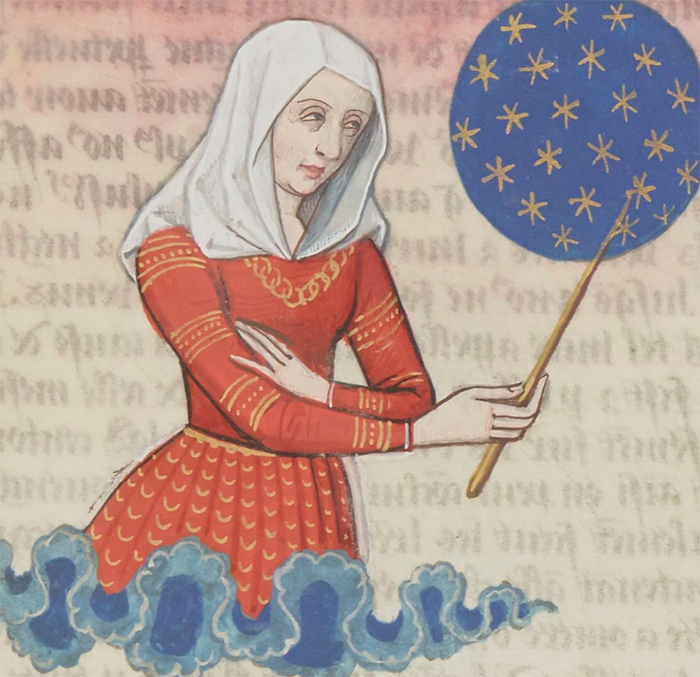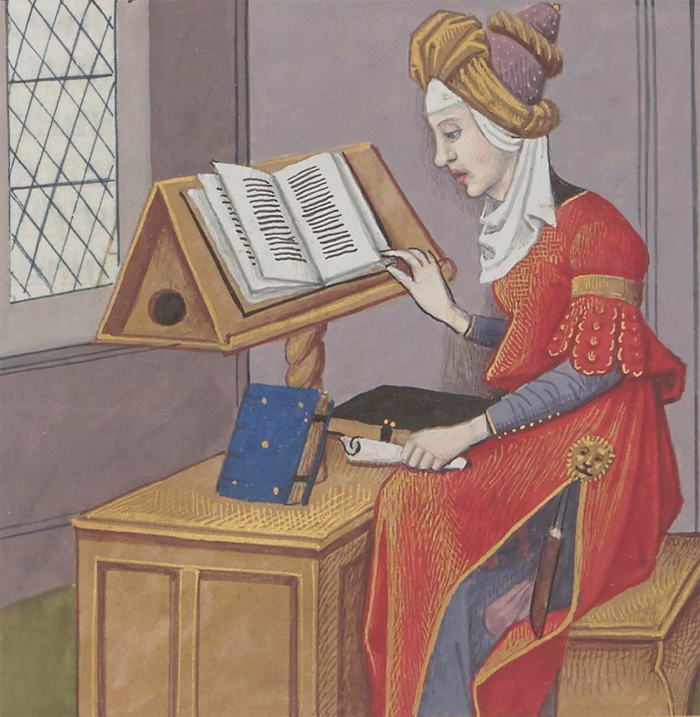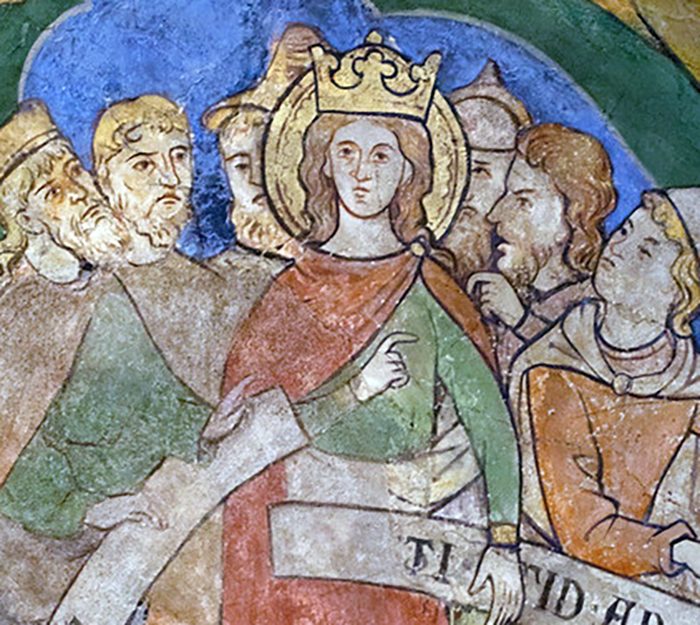In this, the first of a multi-part series focused on women in modern medieval studies based upon an informal survey sent to the fellows of the Medieval Institute at the University of Notre Dame on the occasion of the 50th anniversary of the university’s admission of undergraduate women, we will be briefly exploring both the extraordinary contributions thatIn this, the first of a multi-part series focused on women in modern medieval studies based upon an informal survey sent to the fellows of the Medieval Institute at the University of Notre Dame on the occasion of the 50th anniversary of the university’s admission of undergraduate women, we will be briefly exploring both the extraordinary contributions that women scholars have made to the lives and scholarship of our own faculty members, as well as some of the continuing challenges faced by women medieval scholars in both their scholarship and careers. It is not intended to be an exhausted survey and still less the definitive statement on the matter. Rather, it is an anecdotal collage assembled from the helpful comments of Notre Dame’s own medievalists, to whom I am deeply indebted for their assistance and their candor.
Women Scholars as inspiration

Image of Faltonia explaining the history of the Cosmos from an anonymous French translation of Boccacio’s De mulieribus claris (des cleres et nobles femmes), 1488-1496. Bibliothèque nationale de France. Département des Manuscrits. Français 599, f.83r.
The two most striking points of emphasis in the comments of all respondents were first, the personal inspiration and support offered by women scholars and mentors, and second, the considerable difficulties that continue to confront women within the academy. It is here that we will begin, with discussion of specific research contributions from modern scholars as well as the challenges and importance of studying medieval women to follow.
Many respondents mentioned not only the women scholars whose work has influenced and inspired their own, but also those who provided personal support and directly guided them.
Professor Deborah Tor, for instance, cites the extraordinary Patricia Crone, who, over the course of a career that saw her hold notable positions at the Universities of Oxford, Cambridge, and the Institute for Advanced Study at Princeton, was “the greatest scholar in medieval Islamic history of the past hundred years” and “a figure so towering that she simply could not be ignored”, despite the considerable obstacles laid in her path, but who was also a valued mentor and friend. Professor Tor writes, “I undoubtedly learned more from her about historical inquiry, historical imagination, and the use of evidence, as all these relate to medieval Islamic history, than from anyone else in my life.” Professor Katie Bugyis credits two women with directly shaping the course of her academic career, both of whom we are now proud to count as Fellows of the Medieval Institute here at Notre Dame. The first of these was Margot Fassler, then at Yale’s Institute of Sacred Music whose contribution to the collected volume Voice of the Living Light, edited by the equally remarkable Barbara Newman, left Bugyis convinced “I knew that I had to study with her as a graduate student at Yale’s Institute of Sacred Music. I wanted to keep working on medieval religious women and their liturgical practices, and she was the very best scholar in the field with whom to undertake this research.” Bugyis subsequently made good on her ambition and received her M.A.R. from the Yale Institute of Sacred Music, summa cum laude. When Bugyis was choosing a PhD program, it was another woman who proved the decisive influence:
…when I was deciding between pursuing my doctoral studies at Yale or at Notre Dame, it was meeting with Kathryn Kerby-Fulton that finally tipped the balance in favor of accepting Notre Dame’s offer. Kathryn had been hired by the university shortly after I had graduated from the university as an undergraduate. I was very familiar with her scholarship on Hildegard of Bingen, and during my on-campus visit, I was keen to meet with her to discuss her work on women writers in medieval England. We talked for over an hour, and after that meeting, I left feeling like I knew nothing about the very writers and texts that I wanted to know something about. I was convinced that, if I wanted to become the kind of medievalist that I wanted to become, then I needed to work with Kathryn. I called my partner, Eric, immediately to tell him that we needed to rethink the plans for my future studies. This, of course, was a bit challenging because he was finishing up his doctorate at Yale, but he wanted me to get the best training that I could get as a scholar, and so I ended up accepting Notre Dame’s offer. It was one of the best decisions of my life.
In my own experience as both a student and as a professional academic, it would be all but impossible to overestimate the impact that women scholars had upon me. As an undergraduate, Professor Anne Clark was an invaluable source of guidance and an inspiration in her scholarship on Elisabeth of Schönau, Hildegard von Bingen, and Gertrude von Helfta. While pursuing my M.St. at Oxford, it was Professor Almut Sauerbaum who introduced me to Wolfram’s Parzival and who reliably provided the highlights every meeting held by the University’s extraordinary collection of esteemed medieval Germanists. To this day, I work hard in each and every class I teach to follow the standard set by Professor Jennifer Harris at the University of Toronto, who supervised me over the course of multiple appointments as a TA. The kindness and mentorship provided to me by Professor Bettina Bildhauer at the University of St Andrews, both during my first experience at an academic conference and, later, during my first professional appointment saw me through some of the most difficult moments in my professional development, and neither my dissertation nor any of the scholarship work which has followed would have unthinkable without the work and support of innumerable women scholars, Ann Marie Rasmussen, Elke Koch, Katharina Philipowski, Christina Lechtermann… the list goes on. I consider myself extraordinarily privileged and honored today to count many amongst them as not only colleagues, but friends.

Image of Eriphilia reading, from an anonymous French translation of Boccacio’s De mulieribus claris (des cleres et nobles femmes), 1488-1496. Bibliothèque nationale de France. Département des Manuscrits. Français 599, f.18v.
Challenges Facing Women Medievalists
Yet this long list of remarkable, influential women who have collectively shaped every aspect of my scholarly and academic development also masks some of the darker truths about modern academia. Despite the fact that many of the very foundations for the work that I was to pursue as a graduate student were laid down by women, and despite the enormous influence that the women listed above had upon me, throughout my undergraduate and graduate studies, I found myself shepherded from one male advisor to the next. It was not until the final years of my doctorate that I ever even found myself in a department headed by a woman (in this, case, the ever amazing Suzanne Conklin Akbari). Without in anyway wishing to diminish the accomplishments and contributions of these men, all of whom I account myself extraordinarily fortunate to have worked with, it seems to have been assumed, without ever being verbalized, that for me, a white, cis-male scholar, the path forward lay primarily through other men. Even my doctoral committee consisted of four men and one woman (the aforementioned and remarkable Ann Marie Rasmussen), who joined by special dispensation. All of the other women scholars who contributed did so either unknowingly, through their work, or while remaining essentially unacknowledged institutionally, simply by being decent people, willing to help out a young scholar – doing so, at times, at considerable cost to themselves: time is never free. Mentorship is draining. Especially for junior scholars on the tenure track or under pressure to deliver a book on time, even a weekly meeting for coffee can risk derailing important progress. They did it anyway and continue to do it today for many others.
Although the field of medieval studies is, thankfully, no longer as profoundly male-dominated as it once was, the difficulties faced by women medievalists remain substantial. As one fellow of the Medieval Institute writes of her own experience, “Right before I was scheduled to give a presentation on one of the chapters of my dissertation… a very senior male scholar in the field approached me and said, ‘I am prepared to be skeptical.’ Rightly or wrongly, I keep his words at the forefront of my mind every time I work on my research because the burden of proof still remains so much higher for scholars of medieval women than it is for scholars of medieval men.” Another comments on the “old boys” network that still predominates at many, perhaps most, institutions when it comes to hiring practices:
I know for a fact about the final round of hiring for a position at one of the world’s great universities, which took place about ten years ago. I was told by one of the people who sat on the committee and saw the files that one female scholar led in the written scholarship component, and another female scholar led in the mock–teaching component. Neither was hired– rather, an Old Boy, who had led in neither area, was. Moreover, his principal recommender was also the principal recommender of the female candidate whose written work had put her in the lead, and that recommender specifically ranked the female candidate above the male who got the job. This outcome is quite typical.
This “skepticism” and, at times, outright opposition to the inclusion of women within the academy may be less prevalent today, but it remains all too common. It also exists alongside other, no less formidable, barriers that many women face in pursuing an academic career. Unforgiving deadlines are hardwired into the academic system both in the US and abroad. Deviations from the standard progression are seldom tolerated, and monitoring begins during one’s undergraduate studies. For all academics, this often requires a dedication bordering on fanaticism, to the exclusion of all other interests, be they hobbies, personal relationships, or the interests of family. This last falls especially hard on women, whose graduate studies and early career, generally the highest-pressure phase for academics, coincides with the period of life in which most people so-disposed start families of their own. Such difficulties are only magnified for Women of Color and for those from less-privileged backgrounds. As one MI fellow comments:
Young scholars are all under increasing pressure to publish, with increasing precarity of the job market. But a particular added challenge for women scholars is the continued tension between the expectations of total dedication to career advancement during the pre-tenure phase, and the fact that this is often exactly a period of increasing family responsibilities. This tension has been addressed by many reforms, but remains very difficult to navigate for many; in the end, any progress is continuously undone by the arms race for the increasing number of publications that one is expected to produce, or grants that one is expected to manage, in order to distinguish oneself. In addition, praiseworthy efforts to diversify, e.g., volumes, panels, editorial boards, etc., can become overwhelming for the small number of women scholars who exist in the field.
The fact that, even beyond pregnancy, the burdens of childcare fall, unjustifiably, predominantly upon women, can present an insurmountable obstacle for women who desire or feel pressured to pursue both a career a family life, all but eliminating not only the opportunity to thrive, but even, for some, any entry at all.
To make matters still worse, as mentioned by a number of respondents, such pressures and hostility all too often have a poisonous effect within the community of women scholars. In some cases, competition for the relatively limited number of desirable positions unofficially allotted to women scholars, competition and hostility sometimes result: “[T]he biggest personal obstacle I have encountered in my career was the overt hostility, and even explicit threats… of certain more senior female scholars within my department when I was a junior scholar.”

Catherine disputes with the philosophers, c. 1280 (restored). Ceiling painting from the North Choir Chapel of St. Maria Lyskirchen, Cologne. Photo by Christopher Liebtag Miller.
Here it is worth noting that Medieval Studies, like academia as a whole, presents a diverse landscape. While some general trends may be observed and hold true across the board, there are certain areas in which notable deviations occur. In my own field, Medieval Here it is worth noting that Medieval Studies, like academia as a whole, presents a diverse landscape. While some general trends may be observed and hold true across the board, there are certain areas in which notable deviations occur. In my own field, Medieval Germanistik, for instance, it is striking to observe the dramatic increase in the number of women scholars active since the year 2000. While this evidence may be purely anecdotal, the vast majority of scholars that I find myself citing from the last two decades are women – as, increasingly, are the editors of the texts that I study. Yet when I cite historians who engage with the period in which these texts were created, I find that the number of women scholars publishing become more scarce. With reference to medieval Islamic history, Deborah Tor comments:
Unfortunately, not much has changed. Not only is the field of medieval Islamic history overwhelmingly male, but except in the case of the sui generis Patricia Crone… the work of women typically does tend to be ignored, no matter how fine; or, worse, her ideas appropriated with no acknowledgment. There are some excellent women scholars in the field – Carole Hillenbrand, Louise Marlow, and Beatrice Manz spring immediately to mind– and I have no doubt that were comparable work being produced by men, these women would be occupying endowed chairs at Oxbridge or in the top rung of the Ivy League. But that simply does not happen in the field.
Even where progress in gender equality has been made, the divisions and discrepancies highlighted above point towards a further point of tension: that between fields and subjects that have come to be coded as “women’s’ studies” and those which remain or have become the domain of male scholars. This tension, as well as the manner in which the work of women scholars both past and present has shaped and continues to shape the field of medieval studies will form the focus of our next blog post in this series, to follow in the near future.
Christopher Liebtag Miller, Ph.D.
Assistant Teaching Professor
Director of Undergraduate Studies and Engagement
Medieval Institute
University of Notre Dame



